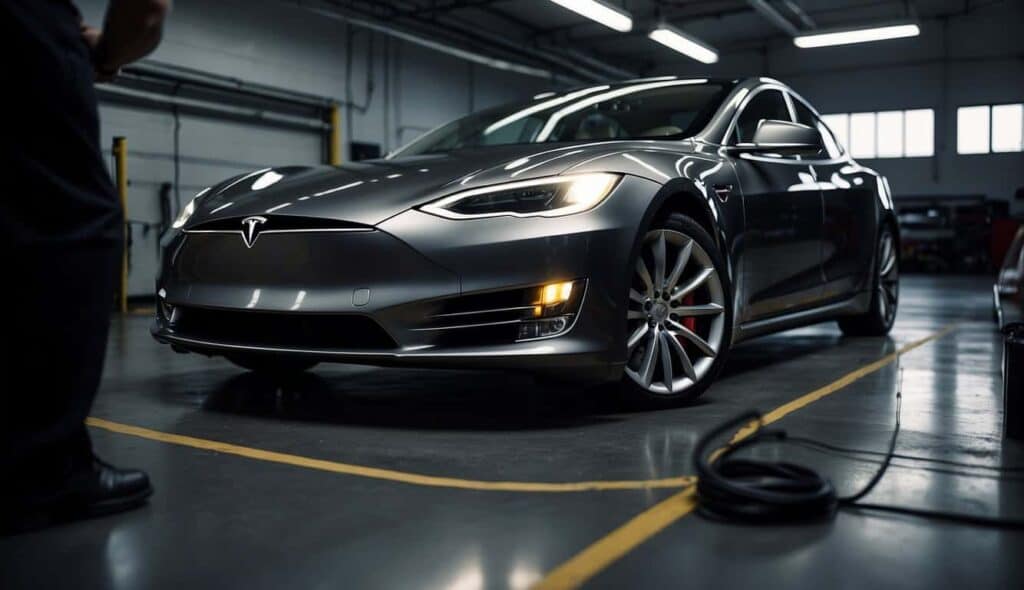Tesla vehicles are known for their advanced technology and electric efficiency. Maintaining a Tesla is crucial for ensuring reliability and longevity. Regular tasks include rotating the tires every 6,250 miles and replacing the cabin air filter every two years.
Tesla’s maintenance requirements differ from those of traditional gas-powered cars. Routine procedures, such as brake caliper lubrication and A/C desiccant bag replacement, are essential. Tesla also utilizes over-the-air software updates and remote diagnostics, reducing the need for frequent service center visits.
Read the complete blog post on what maintenance is required for a Tesla.
Tesla’s Maintenance Needs
Tesla vehicles require regular maintenance to ensure optimal performance. Key areas include maintaining the battery, regular software updates, and understanding Tesla’s warranty.
Maintenance Schedule Overview
Tesla’s maintenance schedule focuses on various components for different models. The cabin air filter should be replaced every two years for the Model 3 and Model Y and every three years for the Model S and Model X.
Brake fluid checks are advised every 2 years. Regular inspections include checking brake pads and discs due to regenerative braking, which reduces wear.
Additionally, battery coolant should be replaced every four years to ensure the battery pack’s longevity. Service appointments are recommended at least once a year or every 12,500 miles. This includes checking and replacing brake fluid, rotating tires, and inspecting other essential components.

The Role of Software Updates
Software updates play a crucial role in maintaining Tesla vehicles. Delivered over-the-air (OTA), these updates ensure that the car’s systems, including the infotainment, navigation, and autopilot, are up-to-date. Updates can improve vehicle efficiency, performance, and range. They can also add or enhance new features, offering a better driving experience.
Frequent updates are designed to fix bugs and patch vulnerabilities, ensuring the vehicle’s safety. Owners can schedule updates through the Tesla mobile app, making it convenient to maintain the car without frequent trips to a service center.
Tesla’s Warranty
Tesla offers a comprehensive warranty for its vehicles, covering several aspects. The basic vehicle limited warranty covers 4 years or 50,000 miles, whichever comes first.
The warranty period for the battery and drive unit varies by model. For Model S and Model X, it covers 8 years or 150,000 miles. For Model 3 and Model Y, it covers 8 years or 120,000 miles.
This warranty includes replacing or repairing components in case of failures free of charge. Regular maintenance and timely service visits help keep the warranty valid.
However, the warranty does not cover damages due to accidents, misuse, or neglect, emphasizing the importance of following the recommended maintenance schedule.
Check out How to Wash a Tesla Electric Car
Electric Powertrain Maintenance
Tesla’s electric powertrain involves unique components and specific maintenance needs that differ from traditional gas-powered vehicles. Key areas of focus include the battery system and brake system.
Battery Care and Requirements
Maintaining the battery in a Tesla is crucial for ensuring long-term efficiency and performance. The battery is the heart of the electric powertrain.
Owners should regularly monitor the battery’s health through the vehicle’s software. Keeping the battery charged within recommended levels can prolong its life.
Tesla recommends charging between 20% and 80% for daily use. Occasionally, charging up to 100% is advised for long trips. Battery coolant is another important aspect. The battery coolant reservoir should be checked and maintained according to Tesla’s guidelines to prevent overheating.
Regular software updates from Tesla also help maintain battery health by optimizing performance and efficiency. If issues arise, Tesla service centers should conduct repairs to ensure they align with prescribed standards.
Brake System Maintenance
Tesla vehicles use a combination of traditional brakes and regenerative braking. This unique system requires special attention to certain components, such as brake fluid, pads, and calipers. Regenerative braking reduces wear on brake pads, but regular inspections are still necessary.
Owners should check the brake fluid yearly or every 12,500 miles. Tesla advises replacing brake fluid periodically to maintain braking efficiency. Brake calipers also need lubrication for smooth operation, which should be done during regular service checks.
Despite regenerative braking reducing wear, traditional brake components like brake pads and calipers should be inspected and replaced as needed. Lubricating brake calipers during maintenance visits can prevent issues and prolong component life.
Regular Inspection and Servicing
Tesla vehicles require regular inspections to maintain efficiency and safety. Maintenance areas include tire care, fluid levels, and specific mechanical components to ensure continued reliability.
Tire Care and Alignment
Maintaining tires is crucial for all Tesla models. It is recommended to rotate tires every 6,250 miles to ensure even wear. Regular tire rotation helps prevent uneven tread wear and extends tire life. Checking tire pressure regularly is also important for optimal performance and fuel efficiency.
Wheel alignment should be checked if you notice uneven tire wear or if the vehicle pulls to one side. Proper alignment ensures better handling and increases tire longevity, making driving safer and more comfortable.
Fluids and Filters
Tesla vehicles require several fluid checks and replacements over time. Brake fluid should be checked every two years and replaced if necessary. Ensuring brake fluid is in good condition is essential for optimal brake performance.
Cabin air filters must be replaced every two years to maintain air quality inside the vehicle. This helps filter out pollen, pollution, and other particles. Windshield wiper fluid should also be topped up regularly, especially before long drives or during winter months.

Additional Mechanical Components
Other parts, in addition to tires and fluids, need regular servicing. Brake calipers should be cleaned and lubricated yearly, especially when roads are salted during winter. This prevents rust build-up and ensures smooth braking.
The suspension system should be inspected periodically for wear and tear, particularly after driving on rough terrain. Additionally, the air conditioning system, including the A/C desiccant bag, should be serviced every 4 years to maintain efficiency and comfort within the car.
By following these guidelines, Tesla owners can ensure that their vehicles remain in top condition and safe to drive. Regular maintenance preserves the vehicle and enhances its performance and longevity.
Read about What is Tesla Premium Connectivity?
Tesla Specific Maintenance Practices
Tesla cars require maintenance practices unique to their electric nature. Key maintenance aspects include regenerative braking and handling repairs with Tesla and non-Tesla certified technicians.
Embracing Regenerative Braking
Tesla vehicles use regenerative braking to recover energy while driving. This system reduces wear on traditional brake pads by using the vehicle’s electric motor to slow down. Brake fluid should still be checked and replaced every two years. This ensures the braking system stays effective and safe.
The brake pads in Tesla vehicles typically last longer due to the reduced reliance on them. However, monitoring their condition remains essential. In car maintenance, understanding the impact of regenerative braking on overall brake wear can improve the vehicle’s efficiency.
Handling Repairs and Services
Tesla offers convenient methods for handling repairs and maintenance. Through over-the-air updates and remote diagnostics, Tesla cars can often be maintained without in-person visits. When service is needed, appointments can be scheduled through the Tesla app.
Sometimes, it might be necessary to use non-Tesla certified technicians for maintenance or repairs. Doing so can affect warranty coverage, so Tesla recommends using Tesla-certified technicians. This ensures the car gets the right parts and expertise.
Regular service intervals include tire rotations, brake fluid checks, and air filter replacements. Keeping up with these tasks helps maintain the car’s performance and extends its lifespan.

Operational Tips for Optimizing Your Tesla
Adopting smart driving behaviors and following a regular maintenance schedule are crucial to getting the most out of your Tesla. Doing so allows you to maximize efficiency, extend the vehicle’s lifespan, and enjoy a smoother driving experience.
Driving Behaviors and Efficiency
Smart driving habits can greatly impact your Tesla’s efficiency. Regenerative braking is one key feature; it recaptures energy during deceleration and feeds it back into the battery. This can extend the range and reduce wear on traditional brakes.
Avoid rapid acceleration and high speeds. These actions drain the battery faster. Using Autopilot can help maintain a steady speed and optimize energy usage.
When planning trips, use the Tesla navigation system. It offers the best routes considering the range and charging stations. Keep tire pressure at the recommended levels for optimal performance and efficiency.
Routine Maintenance and Cleaning
Regular upkeep is essential for keeping your Tesla running smoothly. Replace the cabin air filter every two years for Model 3 and Model Y, and every three years for Model S and Model X, as mentioned in Tesla Support.
Check and top off brake fluid and tire rotation every 12,500 miles. To ensure longevity, maintain the recommendation for battery coolant replacement every four years.
Clean the car regularly to protect its finish. Use soft cloths and avoid abrasive materials to prevent scratches. Inspect and replace windshield wipers and wiper blades as needed for clear visibility.
Conclusion
Regular maintenance is essential for keeping a Tesla running efficiently and reliably. Tesla vehicles are designed with fewer moving parts than traditional cars, which reduces maintenance needs.
Maintenance Schedule:
- Annual Service: Tesla recommends a service appointment at least once a year or every 12,500 miles. This includes checking and replacing brake fluid, rotating tires, and the cabin air filter.
- Brake System: Regenerative braking reduces wear, extending the life of brake pads and discs. Still, they should be inspected occasionally and replaced as needed.
- Battery and Software: Tesla provides over-the-air software updates to improve efficiency and performance. Battery health checks are also important for longevity.
Electric vehicles often require less maintenance compared to gas-powered cars. Proper care includes:
- Checking the brake fluid every 2 years.
- Regular tire rotation to ensure even wear.
- Keeping software up to date for better performance and safety.
Driving Behaviors:
Efficient driving can prolong the lifespan of the vehicle. Smooth acceleration, braking, and regular charging habits can contribute to the car’s overall health.
You may also like:

Hi, I’m Marybeth, an electric car enthusiast living in New York in the USA. As the owner of electriccartalks.com, I love sharing my knowledge on EV tips, battery maintenance, and charging solutions. As a proud Tesla owner, I blend my personal experiences with professional insights to offer valuable information to fellow EV enthusiasts. Through my articles, I aim to empower others to make informed decisions about their electric vehicles. Read more